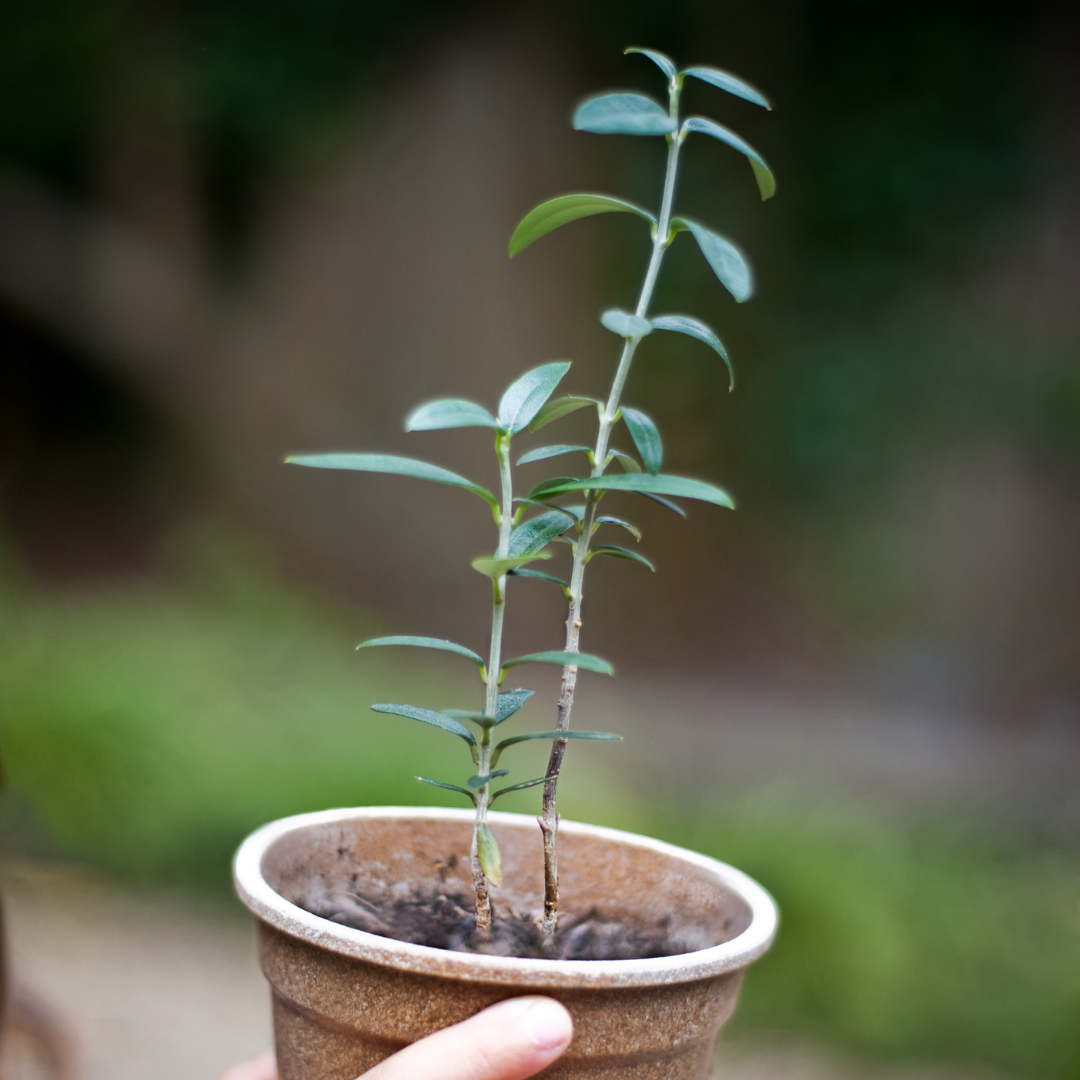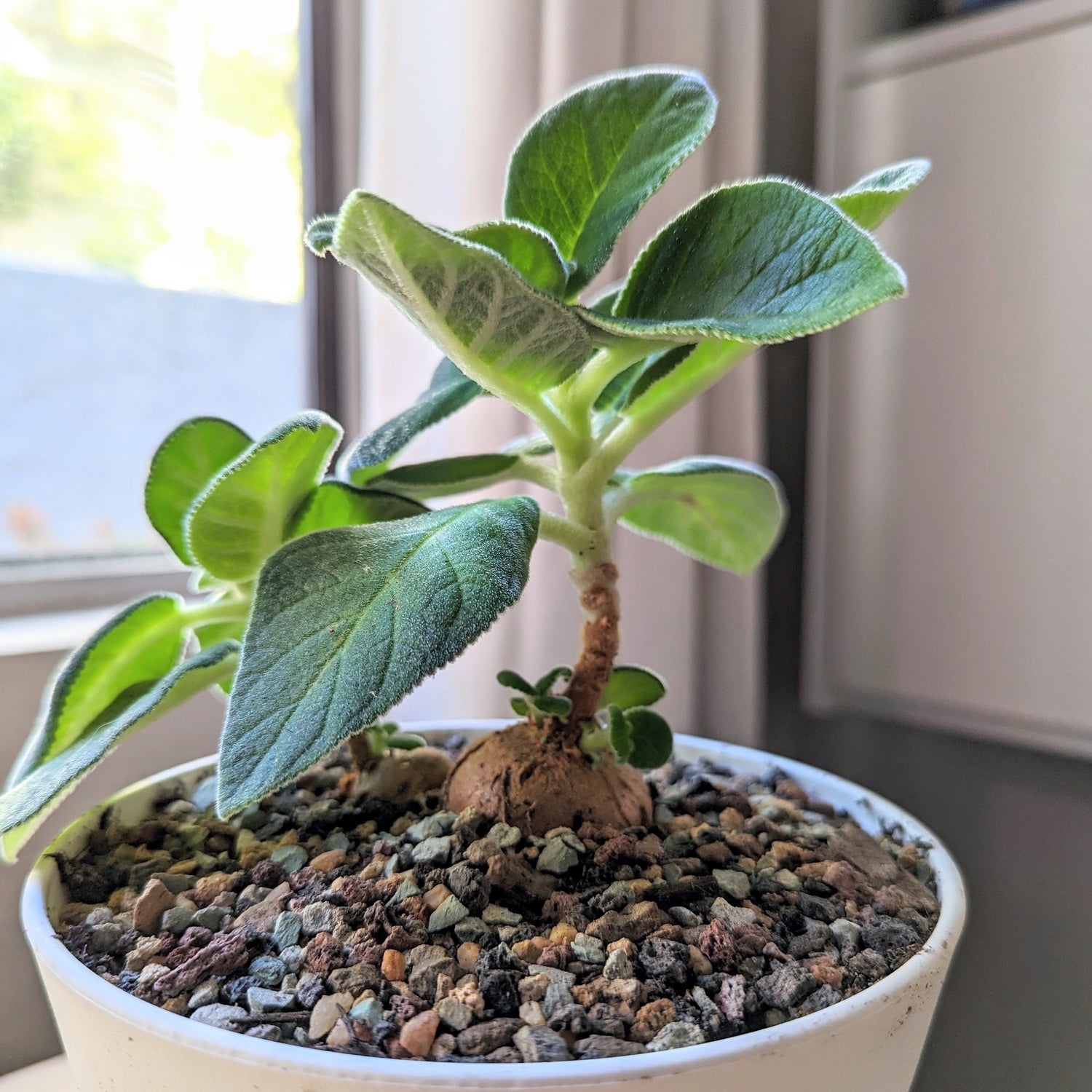A lot of you gardening hobbyists out there may not have the space and light situation you’d like to have(that’s me!), but if that’s what’s keeping you from starting a veggie or herb garden, hopefully this article will inspire you to give it a try! I’ve been obsessed with gardening basically since I could remember, when I would spend many summers in my childhood helping my grandmother tend to her veggie and flower gardens at her farm in Russia. I’ve never had the light or space to have a proper garden of my own in the US, but over time I’ve figured out ways to successfully keep around some veggie and herb plants.

Happy lemon balm growing on a west-facing kitchen windowsill
The seeds we sell in the shop are specifically selected because they do well growing indoors, including the veggies and herbs! So, if you’ve been thinking about adding some veggies or herbs to your houseplant collection, here are some great tips to start with :)
Step 1) Assess your lighting situation
This helps you identify which plants will work best in your home. Specifically, consider that fruiting varieties like tomatoes or cucumbers need a lot more energy than the leafy veggies. It makes sense, tomatoes need to grow to produce enough leaves, flower, and then pour in all that energy to produce the fruit, in contrast with arugula which just needs to grow the leaves.
In your home, you basically have three possibilities, light-wise:

The first time I grew veggies indoors, it was a mishmosh of lettuce, tomatoes and cucumber I grew in empty bean cans :)
-
Bright, natural light with at least one south-facing window: This is the ideal, and the kind of situation that makes me turn green with jealousy! This kind of window lets you grow fruiting varieties and get decent yields! It still probably won’t be as effective as growing the plants outdoors, but it works pretty well.
-
Grow Lights: if it’s in your budget, some good grow lights are very handy to have. This would let you grow essentially anything you like, WHEREVER you like. I’ve added grow lights under a kitchen cabinet to create a little garden on my counter, and transformed a book shelf into a plant shelf. The flexibility is definitely a perk!
-
Low light, we’re talking primarily north facing windows with minimal sunlight indoors, which is my situation. I have a kitchen west-facing window, one in the living room, and a north facing window and patio. The west-facing windows would work great, if they weren’t also shaded by a tree and buildings… Nonetheless, you can see in the photo above that I had some veggies growing at my west-facing windowsill. So if this is your situation, you’ll want to stick to your leafy greens and herbs, however, you can toss in some root veggies and even try out some peppers or tomatoes if you’d really like. I’ve actually done this before, and while yields are minimal, they are there!!

One of my shelves I added grow lights where I grow all kinds of veggies. Up front is a beet, and to the top left a tomato plant, then throughout there is red cabbage, green onion, onion bulb, cucumber, eggplant, lettuce, spinach and even a dwarf coffee seedling!
Step 2) Assess how much space you have
This one is pretty straightforward: the more room, the more variety. Some like beets or carrots, need big, tall planters anywhere from 9”-12”. Tomatoes, Cucumbers, Eggplant, radishes need medium planters, I’ve personally grown some in 4” planters, but the bigger the better! In contrast, leafy greens and herbs don’t tend to require as much room since the roots don’t grow as deep. I’ve grown plenty in 2” planters, but something closer to 4”, or wide windowsill planters work great!
Step 3) Make your plan of action, get your materials!

My little north-facing patio, by using planters that sit atop the wall I’m able to maximize the light that reaches the plants, and they’re big enough to grow root veggies!
Gardening in small spaces is all about maximizing vertical space, which can also often help your plants get more natural light!
There are several ways to creatively use what space you do have to fit as many planters as possible, so if you need some inspiration, you can check out this post I wrote on some small-space gardening ideas here.
Step 4) Plant the seeds
When you plant the seeds, make sure they’re in a warm, humid spot. Cover the seeds with a ziploc baggie or dome for better germination rates! Better yet, read up on our seed guide for getting the seeds to germinate. Just make sure when they sprout, you remove the cover and provide as much light as possible. Putting new seedlings out directly in the sun may burn them, so bright indirect sunlight, or just some morning or afternoon sun rays is great until the seedlings acclimate to full sun. If you’re growing them under grow lights, you can just keep them under the grow lights.

My diy hanging garden I had in my patio before I added the wall planters. I had several successful batches of peas, cucumber, tomatoes and lettuce plants!
Step 5) Experiment! And maintain :)

My little diy hanging herb garden, made with reused tomato puree cans and a simple lattice.
Something I heavily encourage in anything you do- I am a scientist by training, so, experiment!! Try placing the plants in various spots to see where they get the best light, test out different setups, etc. Just make sure to keep an eye on pests, and water regularly, way more regularly than you would typically water houseplants. The smaller the container, the more often you’ll need to water. For reference, I grow some veggies in 2” planters, and I need to water those daily.
Certain plants also benefit from some trimming, like sweet pepper or tomatoes, so they grow more bushy as opposed to leggy. If you’re growing leafy greens, you can harvest the bottom leaves regularly to keep the plants producing more leaves(and you can have more regular harvests!)
That wraps up this post, hopefully you found it useful! If you’re looking for some seeds to start with, try out a collection! We have 3 herb and veggie collections in the shop, namely the “Leafy Greens”, “Cooking Herbs”, and “Herbal Teas” Collections, all of which are great starting points for indoor gardeners :)
Don’t stop researching there! Here are some other awesome articles worth checking out:





